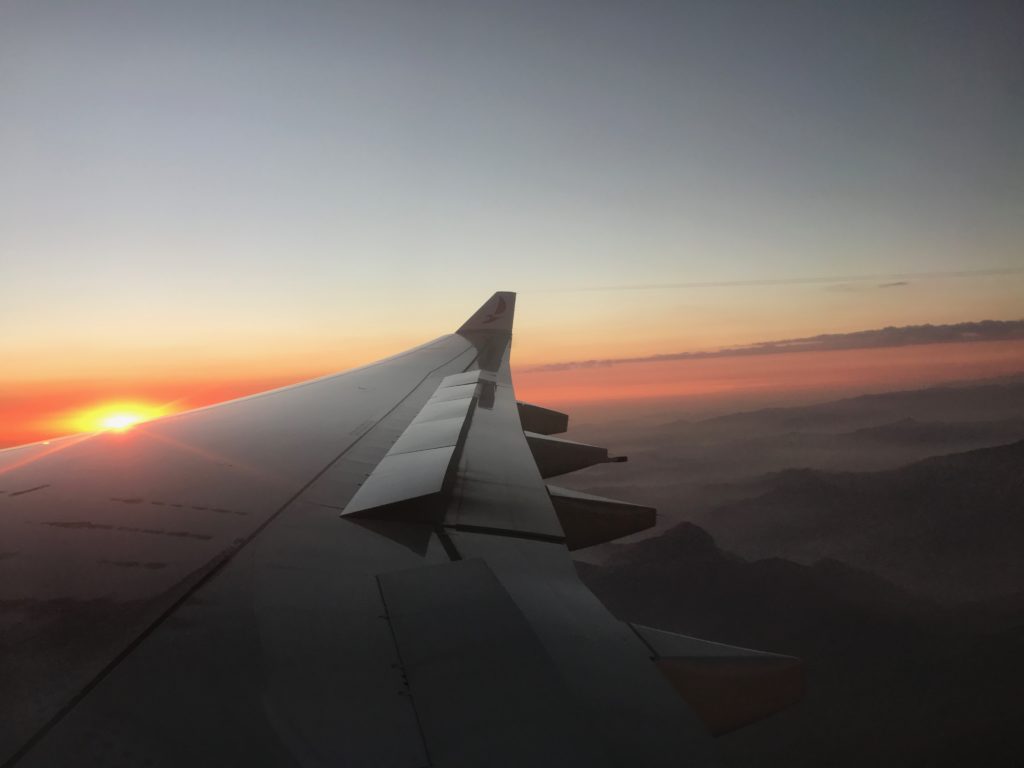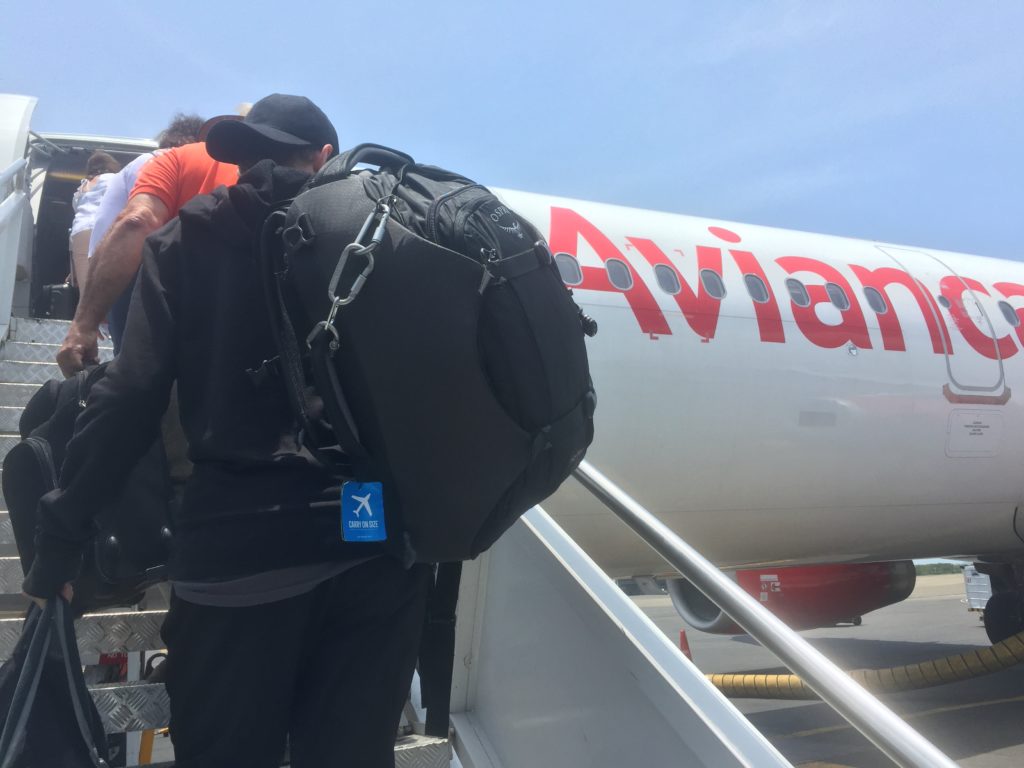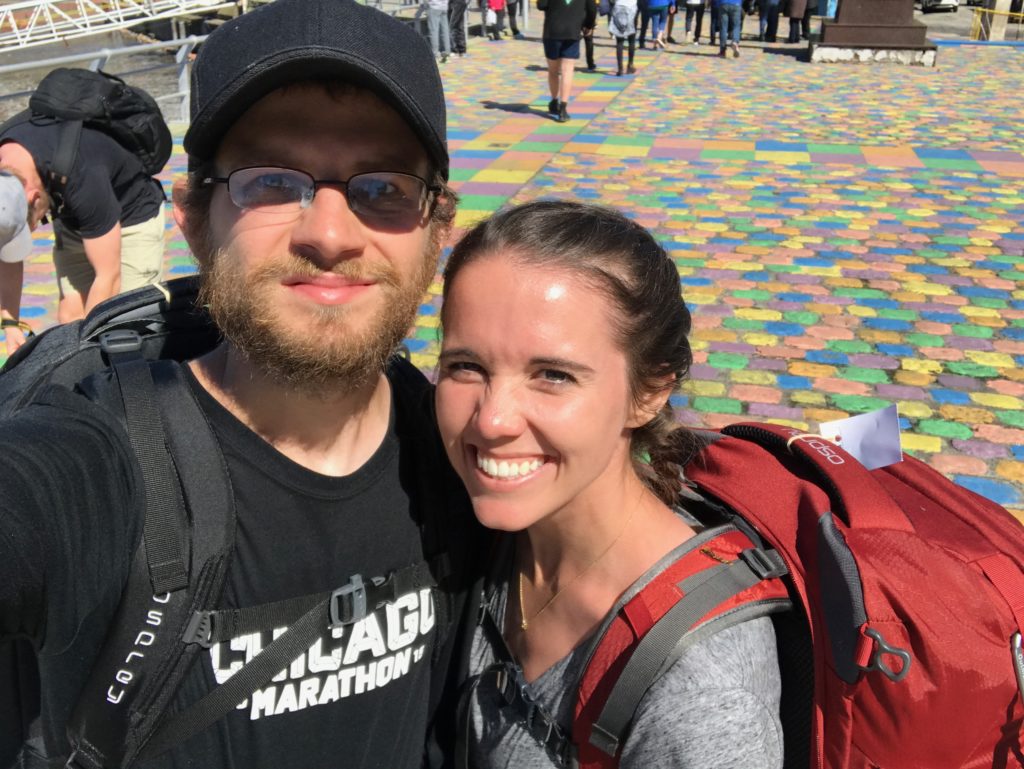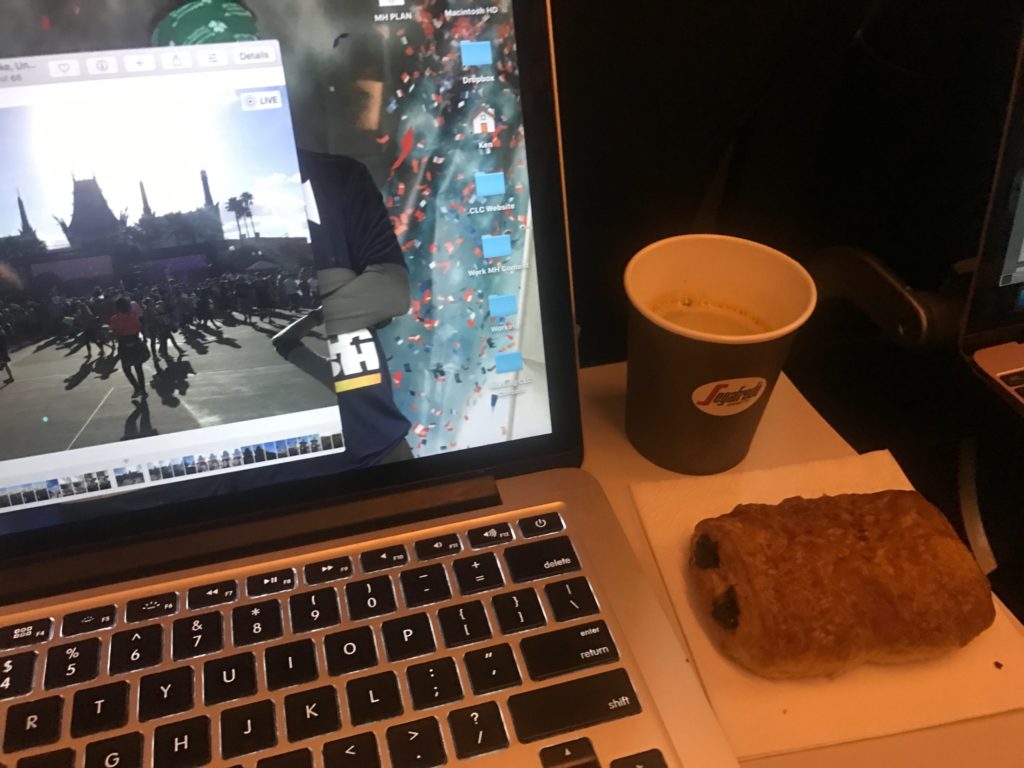Before we even left the US last summer, we had our first six months of travel fully planned: flights booked and accommodations reserved. As we enter the second half of our trip, we’re back on the travel-planning train as we try to figure out where we’re going, when and how much it’s going to cost. And for the second time in as many months, I’ve broken my vow to not fly economy on long-haul flights. But I’m prepared to make excuses again. In this post, we’ll cover why we decided to fly Scoot from Osaka, Japan to Singapore and why we didn’t use points. We’ll talk you through some of the Scoot “extras” that we decided to purchase (plus some we didn’t) and a few general tips on flying low-cost airlines.

Even economy flights have nice views, though
Getting From Tokyo to Singapore
We’ll be wrapping up our February in Japan. Specifically, we’ll be checking out Tokyo Disney Resort and then running the Tokyo Marathon on February 25. Having decided to leave Tokyo on February 27, we were left with a 12-day gap until we wanted to be in Singapore on March 7 (we’ll be flying out on Singapore Airlines Suites on March 11).
Originally, we considered a quick trip to Australia or Bali. However, we wound up hearing so much great stuff about Japan that we decided to push back those other trips to add more time in Japan, specifically hoping to make it to Kyoto and Osaka. This meant we now needed to get from Japan to Singapore on or around March 7.
A seven-hour flight is tricky. You fly overnight, and it’s not really enough time to sleep. Flying overnight economy isn’t really something we were interested in, but if you’re going to use your points for a seven-hour overnight business class, then it had better be a business class option really worth flying. As much as we’re sure Japan and Singapore are going to be amazing places, we decided we’d rater take a day of working on the plane during a day flight than trying to squeeze in a quick, sleepless overnight flight.
The last piece of the puzzle was around connections; something we weren’t really interested in and ultimately what our choice really came down to. To avoid a connecting flight, we had the choice of either flying from Osaka straight to Singapore or transiting back to Tokyo (probably via bullet train) and flying out of there.
Using Points From Osaka/Tokyo to Singapore
The most tempting option was to try to fly Singapore’s A350 from Tokyo to Singapore, but there were a few downsides. There was no saver level business class availability (not even waitlist), so that wasn’t actually an option. Then there was the premium economy option for 32,500 points per person, which we strongly considered. However, that flight arrives at 23:20, which would mean:
- A full day of travel
- Spending probably $100 per person to get from Osaka back to Tokyo (via train)
- Spending 65,000 points (plus whatever fees) for the flight
- Flying a product very similar to one we’ve already flown back in September when we flew premium economy on Singapore’s A380 (which we weren’t blown away by)
Sorry, no dice. This left us basically with two options. We could fly Singapore economy for 25,000 points each from Osaka to Singapore (the cash cost of the flight was $627) or fly Singapore’s wholly owned low-cost subsidiary, Scoot.
I initially wrote off Scoot because of the consistent negative customer reviews they receive online, but that was silly. A big part of our travel strategy revolves around flying low-cost airlines. We fly Frontier and Spirit between Chicago and Orlando frequently. We recently booked a cheap Norwegian fare from London to Los Angeles. All these airlines get some negative reviews, but the trick for all of them is to learn their rules and to play by them.
Booking Scoot 701 From Osaka to Singapore
So, we decided to fly Scoot and tinker a bit. The actual flight only cost about $250 USD for two people. That’s a steal for a seven-hour flight. If all we had to travel with was a small backpack, we’d have no qualms about the flight at all. Stick us in a metal tube between Osaka and Singapore for seven hours for $125 each and we’re sure we’ll do just fine. But we’re backpackers, which means we have backpacks. Big backpacks.

Most Airlines would consider our backpacks carry-on size, but it can vary by airline and Scoot says no dice.
Rethinking Our Packing
In many cases, our backpacks are small enough to count as carry-on bags. They meet Scoot’s size requirements in that regard, but they’d be too heavy. We each come in between 10 and 15kg. Scoot has a 10kg cutoff for your personal item + carry-on. This left us two options: pay to check a bag or pay for an extra cabin bag.
The most cost effective option would have been to pay $30 for a checked bag and consolidate our heavier items into it. The checked bag cutoff weight is 20kg (for the standard price), so we should have been able to make it. But one of the most important rules of low-cost flying is to avoid having to interact with any customer representatives if you can (you can also read our survival guide to low-cost airlines on our sister-site, Mouse Hacking). That means no checking bags. Checked bag lines can be huge and (especially on low-cost airlines) move very slowly as everyone fights over getting nickeled and dimed. We might get stuck in the line anyways if online check-in doesn’t work out, but we weren’t about to commit to it.
Another option was to buy a single extra 7kg carry-on at $30 and do the same heavy item shifting. That would have been a tighter fit, though, as we’re not sure we’re under 27kg combined.
So we sprung for two extra carry-on bags. This means we’re entitled to a total of four carry-on bags and two personal items totaling 34kg. Should be more than enough, and it brought the cost of our flight up to about $155 each.

Our backpacks are heavy, but nothing we can’t carry for a three hour walking tour through La Boca, in Buenos Aires.
Definitely Board Us First
Then there is the “board me first” option, available for $4 per person (which could end up being useless because for only $4, there could be a lot of people ready to board “first”). Baggage issues are much more a thing as the plane starts to fill up, so getting on early was really important to us. This was easily worth the $4 each.
Seat Selection – Scoot’s ScootinSilence Section
Next, there was seat selection. While we’ve seen reports that ScootBiz can be reasonably priced, it was not in our case, coming in at over $600 per person. We’re small people, so luckily leg room is never an issue for us. We do enjoy our peace and quiet, though, so Scoot’s “ScootinSilence” cabin (no kids) sounded like a great option. It also put us at the front of the plane, great for getting us through immigration quickly after our late arrival. Seat selection cost us about $14 per person.
We fully respect children and their right to share our airspace as much as all humans of all ages and volumes, thanks largely to this great post re: babies on planes by Angelina Aucello. If there was a no-snoring section though, we’d pay to stay in that cabin too.
Inflight Wifi
Finally, there was wifi. Wifi on longhaul flights is always hit or miss. We’re not banking on having it, but we purchased 100MB each for $16 each. We always prep to work on planes without wifi, but having it available will at least be something of a safety net for the seven-hour journey.

One of many times a tray table has doubled as an office.
What About Food?
One thing we didn’t mention yet? Food. Scoot has one of the most notoriously draconian food and drink policies possible. They don’t allow you to consume outside food or beverages on their flight. We definitely would have sprung for a vegetarian meal option had there been one, but our only option was finger sandwiches for about $14 per person. We’ll wind up buying water onboard (seven hours in the air is too long without water), but we’ll pass on the meal. Priority Pass gets us access to the KLM Lounge in Terminal 1 at KIX, so hopefully we’ll be able to make use of that and fill up before our flight.
Adding it Up and Using Our Ritz Visa Travel Credit
In total, the cost for this flight comes out to $189 per person, broken down as follows:
- Flight: $125
- Extra Bag: $30
- Board First: $4
- Seat Selection: $14
- Wifi: $16
- Total: $189
As with our recent booking on Norwegian, we split this booking over two cards. The reason is that we wanted the flight portion on our Chase Sapphire Reserve to earn 3X points on travel, but we needed the extras on our Ritz Visa so we could use the Ritz Visa travel credit. Luckily, you can modify your Scoot booking after you’ve made it and pay with a different card, only paying the processing fee once.
How Will This Go??
We’ll see. Scoot flies a 787, which is a nice plane to be on, and as long as we avoid any baggage-related issues, I don’t see us having any problems. The funniest part of all this? Our Osaka-Singapore-London-Los Angeles itinerary now looks like this:
- Osaka to Singapore on Scoot airlines economy class, cash value $125 per person
- Singapore to London on Singapore A380 First Class Suites, cash value $6,943 per person
- London to Los Angeles on Norwegian economy class, cash value $233 per person
If you didn’t believe us that we are advocates of a healthy balance of low-cost airlines and amazing international first class redemptions, I hope you do now!
We’re looking forward to sharing how this trip turns out!
